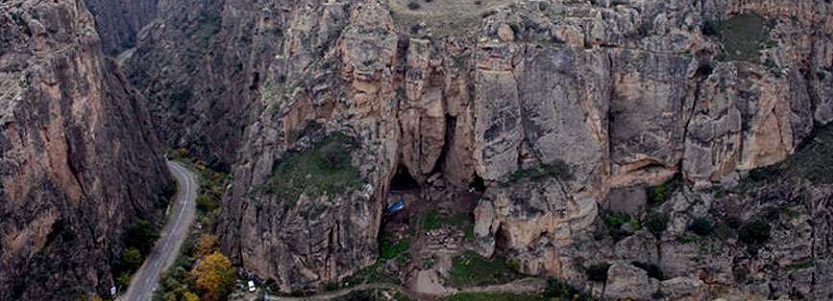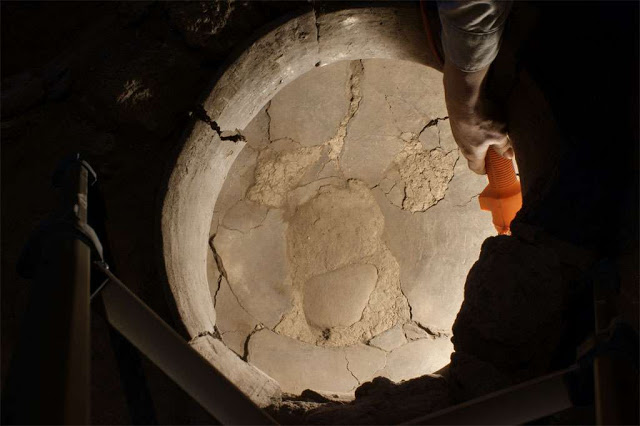
When one tries to calculate the exact age of wine, many researchers findthemselves in a dead end, because at every scientific discovery, this nectar of thegods is placed even further behind in human times. Wine has seen manycivilizations born, grown, aged, and died. However, it always remains – mucholder than Rome and its ruins, older than Greece and Macedonia, older than thecivilizations of Mesopotamia. It is a fact that wine has always been present inhuman history. And Enovírtua brings another excerpt from this important storyso that you, wine lover, can always be well informed.
Enovíritua Writing Room
The oldest factory of wine and the episode ofpatriarch Noah


The oldest wine production unit ever found is about 6,000 years old.
It was unveiledin Armenia according to the Paris daily newspaper «Le Monde».
Archaeologists have even identified the crop of dry red wine produced there usingbiochemical techniques.
The finding was published in the scientific journal Journal of ArchaeologicalScience.
The study was conducted jointly by academic and scientific bodies from the UnitedStates, Ireland, and Armenia.
“This is the oldest wine-making facility in the world,” said Gregory Areshian, who isresponsible for the work and deputy director of the Cotsen Institute of Archeology atthe University of California, Los Angeles.

The excavations were carried out in a cave complex, known as Areni-1, in theArmenian province of Vayots Dzor, Little Caucasus, near the border of Armenia withIran. The wine was intended for worship.
Near a wine press was also identified a dehydrated vine, grown around 4,000 BC.
The earliest known wine production was found at the tomb of the ancient Egyptianking, Scorpion I of 5,100 years.

In the same cave of Armenia, the team unearthed in 2009 the oldest leather shoe inthe world, approximately 5,500 years old.
The grapes were crushed in a shallow basin of clay about 1 meter in diameter.
Seedsand dried grapes were gathered around it.
The juice was obtained by steppingbarefoot on the fruit, Areshian said.Copper equipment was collected to process wine, impregnated vases of wine andeven a goblet and a bowl.
«This was a relatively small installation, related to a ritual inside the cave. For daily consumption, villagers would have much larger presses in normal establishments,»added Areshian, who was also deputy prime minister of the first independentgovernment of the Republic of Armenia in 1991.
In the region of these caves the wine culture is very old and good red wines of Merlotand Cabernet Sauvignon are produced.

Patrick McGovern, scientific director of the University of Pennsylvania’sBiomolecular Archeology Laboratory and author of books on the origin of wine, hasshown that the type of seed collected – Vitis vinifera vinifera – continues to beharnessed in the region.
McGovern recalled that «even in the lowlands like Ancient Egypt where beer reigned,special wines were required in funeral offerings; and great volumes of wine wereconsumed in the greatest religious and royal festivals.»
In a book, McGovern argues that the «wine culture» first developed in themountainous regions of Armenia, from which it spread to the plains of the south, andthen to the whole world.
The archaeological discovery suggests an interesting approach.

According to biblical tradition Noah’s Ark would have stopped in Armenia afterthe Flood. And there descended the Patriarch and his descendants.
Probably there also happened the fact described in the Bible in which Noahdrank wine and lost his senses.
This new finding provides scientific support in collateral to the biblical tale.
Approximation or collateral support is not linear proof, but it helps to compose thepicture of the historical event. And, in this sense, it speaks in behalf of the factsnarrated in the Bible.
The fact that the other oldest wine factory is in Egypt, a thousand years younger,leads us to ask whether in that millennium – that is to say between the year 6000 BCof the Armenian wine factory and 5,100 BC of the Egyptian one – it would not havehappened the dispersion of peoples.
After the dispersion of peoples, they would have departed bringing the knowledgethat was common to all of them. The manufacture and consumption of wine, among them.

However, the dating of the flood, previous to the historical reference to Babel, and tothat of the dispersion present difficulties that would take the space of another post.
The existence and characteristics of the flood are the most universal of the traditionscollected in the most distant people, including among the Indians of Brazil.
This is how Genesis 9 teaches about the episode of Noah and the wine:
20. Noah, who was a farmer, planted a vine.
21 And having drunk wine, he was drunk, and appeared naked in the midst of his tent.
22. And the father of Canaan saw the nakedness of his father, and went and told it tohis brethren.
23. And Shem and Japheth took a cloak, and put it upon their shoulders, and went tocover their father’s nakedness, walking on their backs; and they do not see thenakedness of their father, because they had their faces turned away.
24. When Noah awoke from his drunkenness, he knew what his younger son haddone to him.
25. «Cursed be Canaan,» he said; «May he be the last of his brothers’ slaves!»
26. And he added, «Blessed be the Lord God of Shem, and let Canaan be his slave!
27. May God stretch out Japheth; and let him dwell in the tents of Shem, and letCanaan be his slave!»
Source: https://cienciaconfirmaigreja.blogspot.com.br/2017/06/a-mais-antiga-fabrica-de-vinho-e-o.html





